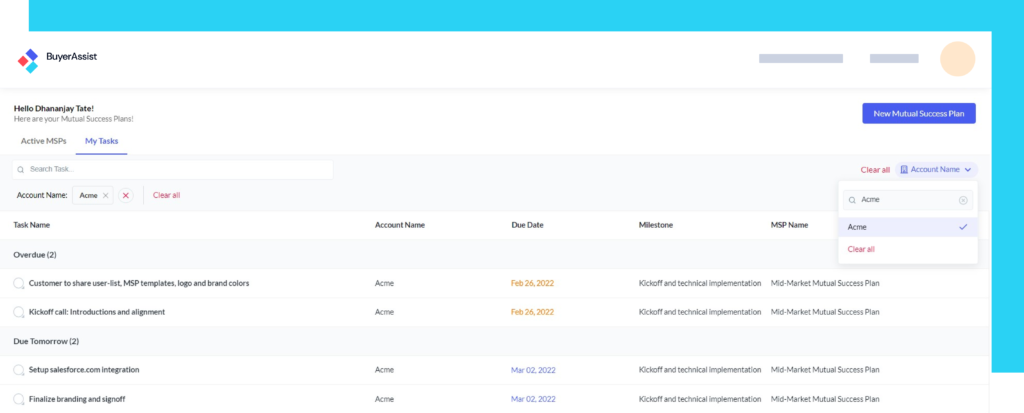 BACK TO BLOG
BACK TO BLOG
Get company-wide customer success by using Mutual Success Plans

 BACK TO BLOG
BACK TO BLOG

We saw in my previous blog why a Mutual Success Plan is necessary for a customer-success organization in SaaS. That blog aimed to demonstrate the current business challenges and position the mutual success plans as a one-stop collaborative, living, evolving platform, both for internal stakeholders and customers, which aims to reduce friction via outcome-oriented project management. It also provides all the mechanistic details necessary to understand the trajectory of outcomes to both buyer and seller alike.
In this article, I share some actionable ideas and frameworks to make your Customer Success organization adapt a culture of mutual success plans with their customers.
Traditionally, Sales and Customer Success teams operate in silos. This leads to a doubling of man-hours in client discovery, one each by both teams. This leads to misalignment between what was promised and delivered, causing unnecessary friction, avoidable escalations, and longer time to value. Instead, what we need is a shared, collaborative, and customer-validated single source of truth. A Mutual Success Plan (MSP) is a living document to drive mutual success between your customer and revenue teams (Customer Success + Sales).
What's an MSP? How to design a plan? When to share it with internal and external teams?
A Mutual Success Plan contains various components designed to give different levels/points of view to the participants at different points in their collaborative journey. Let's start from the top.
Business Objectives - a high-level one-liner describing the desired customer goal. For example, this is what BuyerAssist Business Objectives for its customers look like: Customer wants a way to drive predictable and consistent deal execution and customer onboarding to win more deals and accelerate time to value
Reverse Timeline (RT) - Reverse Timeline is a visual representation connecting the key dates along the customer journey. For example, the Go-live is a key date you want to capture as a part of the sales to customer success handoff for any new customer implementation. Based on your previous learnings from other customers, you know the average time for user adoption and implementation to align to make sure you and the client are aligned on other key dates.

Executive summary - Your Customer Success Manager can elaborate on the desired outcome and other details here. We recommend that your CSM and salesperson share the screen (not the mutual success plan at this point) with the customer team during the kickoff call post signature to ensure the customer is aligned with your understanding of the customer's goals. At the end of the call, the mutual success plan owner can share this plan with the customer team, who can then make edits to the executive summary to align with their objectives/context. This is the first co-creation step, and its strategic positioning by a CSM will go a long way in establishing trust in this budding relationship.
The discovery questionnaire, usually shared in an excel file over emails, can thus be set as a permanent milestone in the plan itself. Any evolving business needs, for example, can be reported here, consequently acting as an evolutionary pivot for the entire customer journey going forward.
The Plan, on the other hand, is a vertical and mechanistic representation of all the milestones and the related tasks, complete with ownership/ETA/completion status details. This is where you drive accountability and give a visual representation of the progress, right down to the minute details on where the plan is lagging and on whose account.
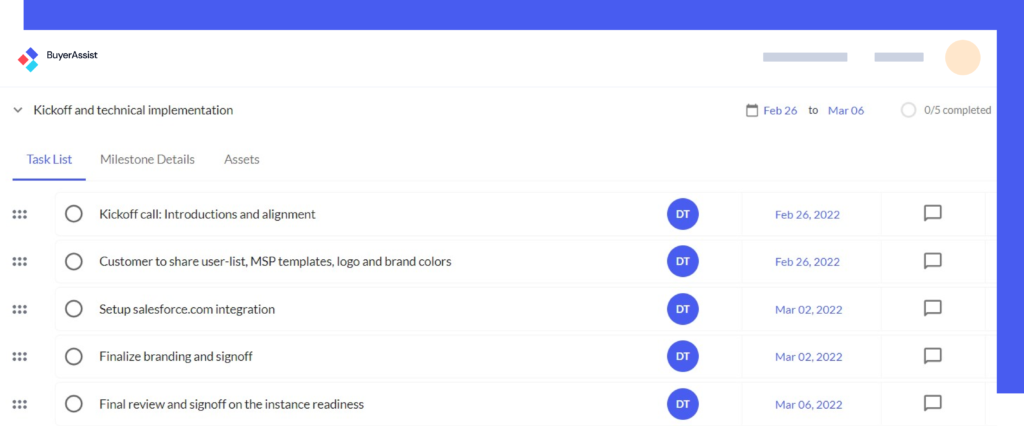
A Plan is a set of milestones, where each Milestone is a collection of tasks with its respective owners and due dates, all geared toward making that milestone successful. You can reinforce the goals you aim to achieve for a given Milestone, define it as successful, and what risk factors you foresee that will sink this phase of the project.
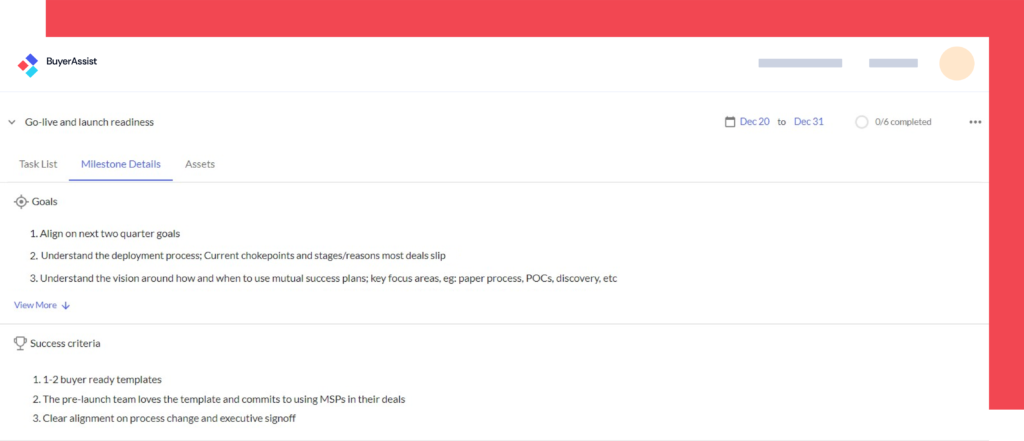
The internal collaborations/communications (e.g., between CSM and Support or CSM and Configuration Analyst) can be neatly tucked away from customer view as well. And the Plan tab is where the real power of the mutual success plan lies.
The barrier to visualizing the communications, the progress, and overall operational details, which were earlier siloed either in emails (Customer Success -customer interactions away from vendor management) or on a CRM (e.g., Log a call on Salesforce away from the customer and limited to the vendor team) is now completely removed and provide a living, evolving unified view of the entire project.
The stakeholder tab will provide a dynamic list of who's involved in the project management from both sides, with more stakeholders addable to the matrix as the case may be, or multiple users to the same role. They can be re-ordered depending on who's leading that particular phase of the project.



How to automate the Sales->Customer Success Handoff?
Usually, the CSMs engage in a post-Sales pipeline, with the AEs "handing over" the account to the Implementation Manager/Onboarding Manager/CSM. This is where the mutual success plans come into the picture.
The AEs will create a mutual success plan during the mid-stages of the sales process.
Once the deal is closed, they will create a Milestone, say, "Sales->Customer Success Handoff, and assign tasks to:
They can also attach the Discovery sheet as part of Assets, which is then readily available to all those with access to the plan.
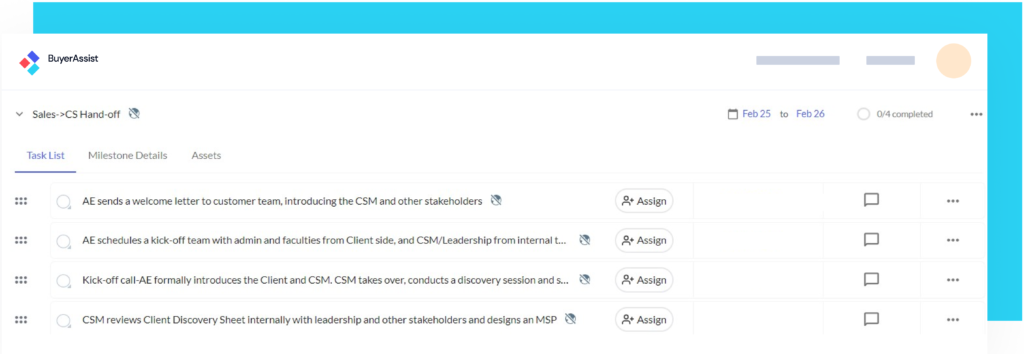

This Milestone (and therefore its Tasks and Assets) can be internalized and thus hidden from customer view as well.
Why is this important? Because the Customer's success and your product's value realization are linked to a successful implementation. And documentation of the complete context of the client's business challenges, pain points, and details of the Discovery calls will only aid the CSM team to:
But is Onboarding/Implementation really a 1:1 task between the CSM and the client team? No. The CSM will work internally with:
All of these internal collaborations are currently spread across tools (think tickets and queues for specific teams or analysts on CRM, interpersonal communications on email, Slack/Teams, and in-person). Instead, why not have these tasks in one frame on a single mutual success plan? All of these tasks can be marked "Internal" by the CSM on a Mutual Success Plan, with separate Milestones, for Instance, creation, Configuration, Feature Requests, and Bug resolution. Going forward, the last two items will also be integrable with custom project management software for product owners and developers. Alternatively, you can also share them with your clients to drive transparency in your relationship.
What next after implementation and Go Live? With my enterprise clients, I touch base with the project managers and associated team members on a weekly or monthly basis, sometimes till almost a year. The communications and outcomes of these meetings were all distributed across multiple email trails, the minutes logged in Salesforce, and the tasks distributed to analysts on CRM and coordinated with on Teams. Think how many man-hours were spent simply managing all these tasks and bringing them to a meaningful conclusion? Here again, mutual success plans come to the rescue by being purpose-built for CSMs to aid in their Cadence. The CSM can build Cadence Week 1 as a separate Milestone, and every action item therein can be logged as a separate task. More details on the task or ETA can be reported under the Comments section for that task.
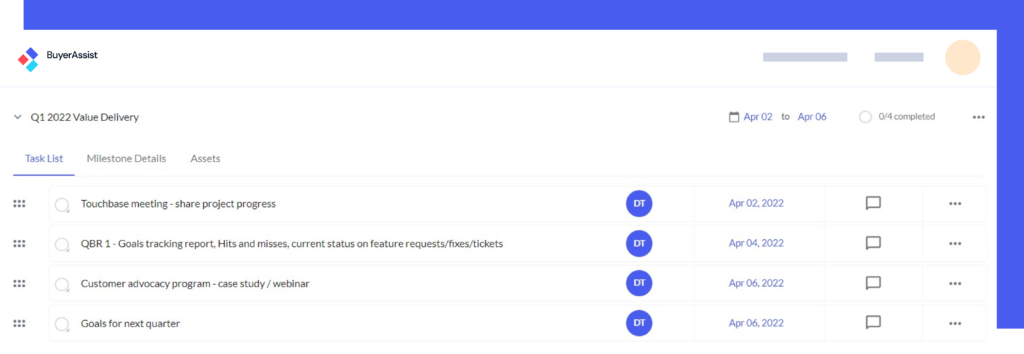

During this particular phase, if the mutual success plans are used to document current and evolving business needs, pain points, and resolutions to those pain points, then as a living document, it will add further value to the QBR. The management on both sides, for example, won't have to wait till QBRs to realize the next set of challenges and how to go about it. The information on the mutual success plan will flow seamlessly from one phase to the next, from one quarter to another, while QBRs or MBRs will simply serve as legacy touchpoints from older CSM workflows.
And finally, as a Customer Success Leader, you can use the landing page to plan your Sprint. Review the plans being worked on by your CSMs, quantify the progress of each project, quickly check which ones are off-track, and strategize on removing the road-blockers.
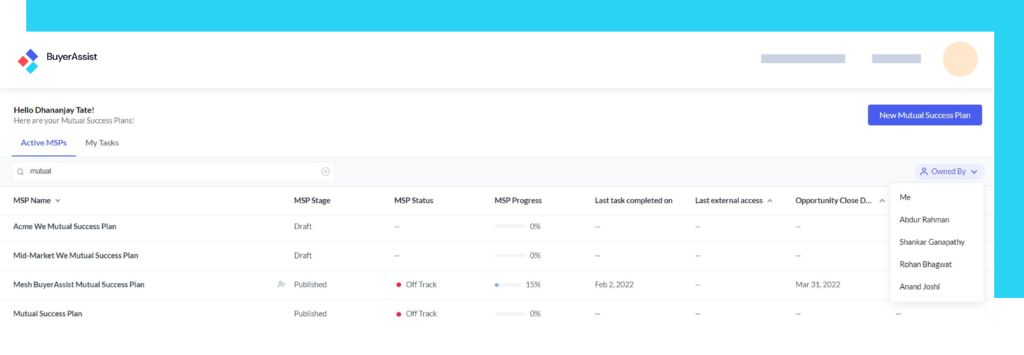

You can also use the My Tasks tab to quickly glance at all the tasks that have been assigned to you for a particular plan, along with its due date. The best time to use this feature is when you begin your shift, take a bird's eye view of the to-do items pending today, and check them off your list.
